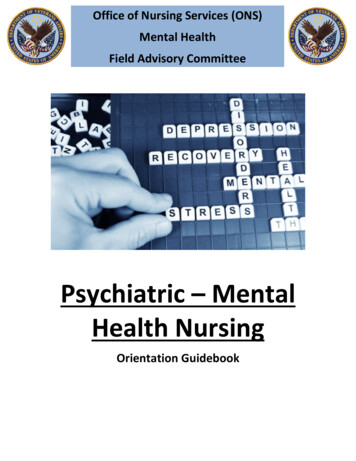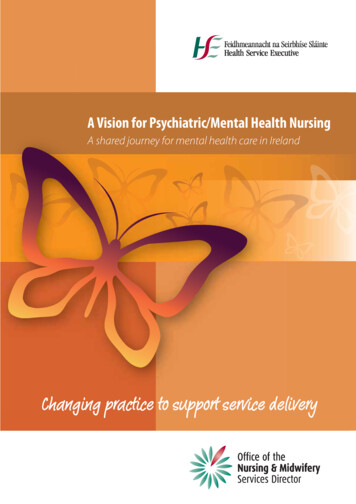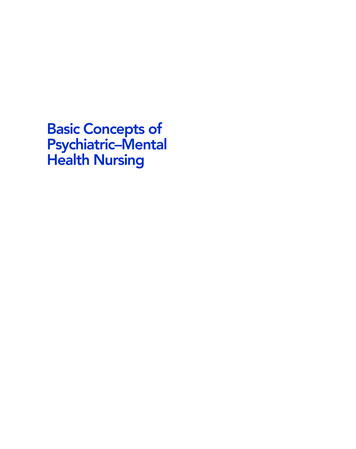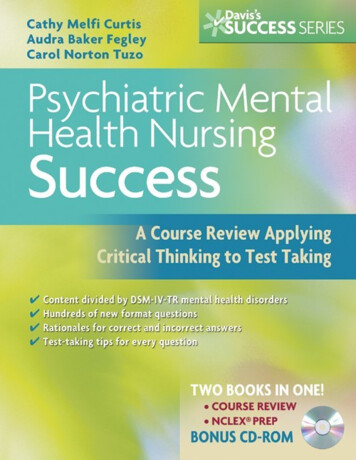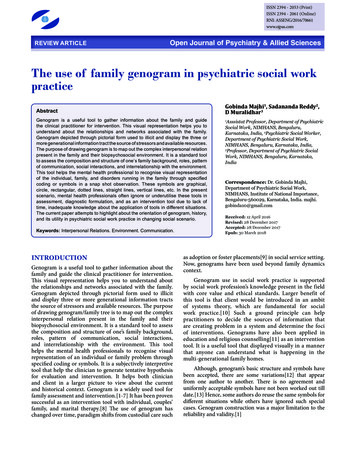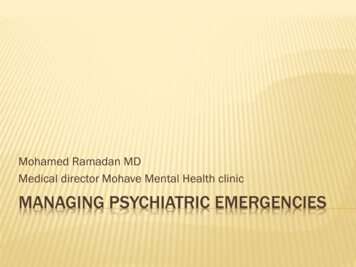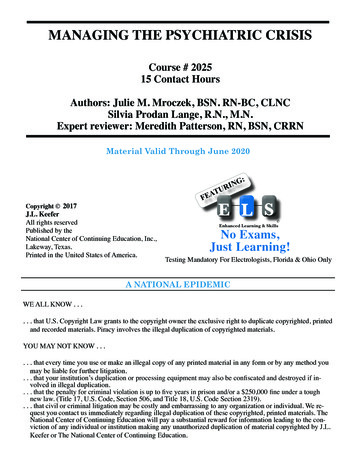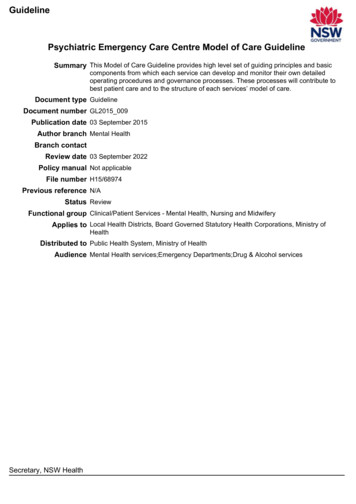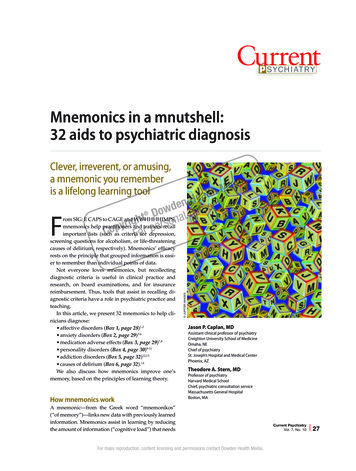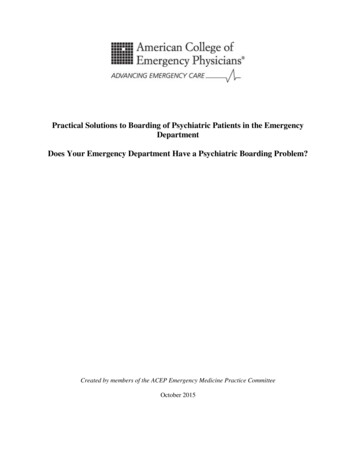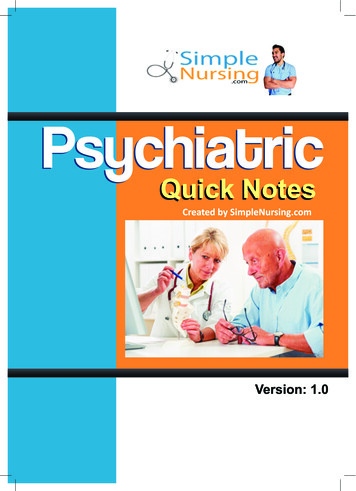
Transcription
Psychiatric Quick NotesTable of Contents123Behavioral Medicine Exam Notes . 31.1Intro to Behavioral Med . 31.2Empathy, Communication, and Counseling Skills . 51.3Relational Problems, Abuse, Neglect, and Rape . 61.4Mental Health Professions and Referral . 91.5Behavioral Change. 101.6Patient Adherence. 121.7Difficult Clinical Encounters . 141.8Stress and Disease . 151.9Crisis Assessment and Intervention . 17Behavioral Medicine Exam II Notes . 192.1Substance Use Disorders . 192.2Toxicology of Substance Use . 242.3Behavioral Medicine Pharmacotherapy . 262.4Working With Specific Populations. 292.5Behavioral Interventions for Substance Use and Other Unhealthy Behaviors . 312.6Patient Education . 332.7End of Life Issues. 34Psychiatry Exam Notes . 373.1Intro to Psych . 373.2Eating Disorders. 403.3Anxiety Disorders . 433.4Mood Disorders . 493.5Somatoform Disorders . 573.6Personality Disorders . 593.7Psychotic Disorders . 643.8Sleep Disorders. 69Page 2 of 72Simplenursing.com 82% or Higher on Your Next Nursing Test 2013 SimpleNursing.com All Rights Reserved.
1Behavioral Medicine Exam Notes1.1Intro to Behavioral Med1.1.1Background NCCPA competencies for PA profession:1. medical knowledge2. interpersonal & communication skills3. patient care4. professionalism5. practice-based learning & improvement6. systems based practice1.1.2Models of Health & Health CareBiomedical model: physical processes such as pathology, biochemistry, and physiology are the primarydeterminants of health -developed in mid-1800sBiopsychosocial model: biological, psychological, and social factors all play a significant role in humanfunctioning in the context of disease -developed in 1977Travis’ wellness model: health is not merely the absence of disease, but a continuum from prematuredeath to a high level of wellness wellness is a process there are still things healthcare providers can do to support patient health when the patient is notactively ill or at a neutral pointPsychosocial model: examines the interplay of the individual with their family, community, and broaderculture an individual’s core beliefs, values, and attitudes influence their health decisions family: systems approach: the evaluation of the patient’s family dynamics and communication in makinghealth care decisions that impact the patient community influences: religion, social services and other resources culture: customs and traits of a racial, religious, or social groupSimplenursing.com 82% or Higher on Your Next Nursing Test 2013 SimpleNursing.com All Rights Reserved.Page 3 of 72
Psychiatric Quick Notes1.1.3Models of Human Lifespan and Normal Psychological DevelopmentStage theories: Freud, Piaget, Erickson, and KohlbergLife course model: stages are defined by certain tasks or challenges, and knowledge of these stages andtheir related challenges help to plan more effective care strategies for patients at any stage there are normal or expected life events as well as abnormal or unexpected life events expected: puberty, functional decline in old age, onset of schooling, joining workforce, etc. unexpected: teen pregnancy, chronic illness, loss of job, divorce, etc.1.1.4Models of Individual Health BehaviorHuman behavior includes affect, behavior, and cognitionsModels: health belief model: patients have certain beliefs based on what they value and expect your belief in a personal threat together with your belief in the effectiveness of the proposedtreatment/behavior/lifestyle affects whether or not you seek that treatment/behavior/lifestyle explains rationale for not seeking medical care: don’t believe they have an illness, don’t see a benefit theory of planned behavior: attitude toward behavior, subjective norms, and perceived behavioralcontrol, together shape an individual's behavioral intentions and behaviors transtheoretical model and stages of change: assesses an individual's readiness to act on a newhealthier behavior, and provides strategies or processes of change to guide the individual through thestages of change to action and maintenancespecific interventions are based on which stage the individual is in Page 4 of 72Simplenursing.com 82% or Higher on Your Next Nursing Test 2013 SimpleNursing.com All Rights Reserved.
1.2Empathy, Communication, and Counseling Skills1.2.1BackgroundTerms: empathy: an intellectual identification with the feelings, thoughts, or attitudes of another whereboundaries of the self are maintained results in increased understanding of the patient perspective without adopting their feelings skills in this may be a clinician’s most important tool as it enhances effectiveness of care, improvespatient satisfaction, and lessens disposition towards malpractice suits sympathy: a temporary loss of self-awareness in which one feels emotionally the feelings of anothersuch that the boundaries of the self are not maintained results in increased understanding of patient perspective along with adoption of the same feelingsHow to maintain clear patient-provider boundaries: define boundaries by asking: is this what a health provider does? do I sense how the patient experiences this? am I doing this for the patient or for me? are my actions supporting the health of my patient? strategies for maintaining boundaries: being patient-centered, manage feelings of personal neediness,monitor for transference (displacement of feelings meant for someone else that come out at the providerinstead), monitor for countertransference (provider’s feelings meant for someone else come out at thepatient), no dual relationships, consult with colleagues if unsure1.2.2Empathy Barriers and How to OvercomeClinician barriers: takes too much time make the time too draining make the effort will lose control of interview be confident in redirecting patient to maintain some control of thedialogue can’t fix patient’s distress be comfortable with patients in distress not my job recognize role as healthcare provider is to express empathy perceived conflict of interest remember there is no conflict of interest in empathy if appropriateboundaries are maintainedSimplenursing.com 82% or Higher on Your Next Nursing Test 2013 SimpleNursing.com All Rights Reserved.Page 5 of 72
Psychiatric Quick NotesPatient barriers: cultural taboo about discussing emotions information patients that mind shared is safe, confidential,and will be respected preference for interpreting distress in a biomedical model remind pt they are welcome to shareemotion somatization disorder relate to pts that the experience of many emotions are a normal part of life desire to meet clinician’s expectations worry about being emotionally overwhelmed inform patient that distressing or disabling emotions mayrepresent a mental health disorder that may warrant further evaluation and treatment lack of language for emotions help pt identify words to express self through empathy1.2.3Communication SkillsSkills are verbal as well as nonverbal verbal tools: make acknowledgements such as mm-hmm, yeah, etc. as patient speaks restatement of what the patient says reflection of what you perceive the patient is feeling validation of patient’s situation express partnership by making statements that clinician is interested in supporting the patient respect appropriate use of self-disclosure: when clinician expresses similarities, etc. with the intention of making the patient feel empathized with, but done in a way to not retract attention away from the patient making use of meaningful silences nonverbal tools eye contact in moderate amounts, no staring facial expression: appearing interested, mirroring concept head nods in moderation, no bobble-heading maintain a 3-4 foot distance during history taking posture: open stanced, relaxed, leaning towards patientCommunication skills are used to assure direct, honest, therapeutic communication with patients, to expressempathy, and to counsel and educateHow effective are you at communicating? intention: what response do you intend to create? action: what skill do you need to yield the intended response from the patient? response: did the patient respond as intended? reflection: how was the experience and what would you do to modify it?1.2.4 Counseling SkillsFirst need to build a foundation with empathy and a therapeutic relationship with patientMake use of communication toolsCoding considerations:if 50% of face to face time with patient is spent in counseling, time may be used as basis for selectionof level of service1.3Relational Problems, Abuse, Neglect, and Rape1.3.1BackgroundIntimate partner violence: a chronic pattern of abuse by a current or former partner in an effort to gaincontrol over the otherPage 6 of 72Simplenursing.com 82% or Higher on Your Next Nursing Test 2013 SimpleNursing.com All Rights Reserved.
one partner hitting another is not necessarily domestic violence, it is the pattern of behavior that isimportantincludes threatened, attempted, or completed physical, sexual or psychological abuse as well aseconomiccoercionoccurs in both same sex and opposite sex relationshipswomen are more likely to experience victimizationRape: vaginal intercourse with an individual against their consent or when unable to give consentSexual violence: general term which includes all forms of unwanted sexual contact, exposure, or advancesperpetrated against an individual without their consent or when unable to give consent 1/5 boys under age 18 have been sexually assaulted 13% of women have been sexually assaulted at some point in their lives rates are higher in veterans and current military1.3.2 Intimate Partner ViolenceAn important health care issue as it is an important contributing factor if not the root of many general,gynecologic, and mental health complaints contributes to health care costs and lost productivity at workand in societyLifetime prevalence of 25% in women and 7-12% in menAlcohol and drugs: often are being used by victim and/or batterer when violence takes place, but they don’t cause thebattering many people drink and they don’t beat their partners injuries are more likely to be severe if batterer is drinking as their judgment is impairedLeaving the abuser: a victim is at the greatest risk of being killed at the time of trying to leave because the batterer’spower and control is threatened 75% of domestic murders occur when the victim and batterer are separated however, abuse tendsto increase in frequency and severity over time may victims don’t know about resources available tothem shelters often have restrictions t
Simplenursing.com 82% or Higher on Your Next Nursing Test 2013 SimpleNursing.com All Rights Reserved. Page 3 of 72 1 Behavioral Medicine Exam Notes 1.1 Intro to Behavioral Med 1.1.1 Background NCCPA competencies for PA profession: 1. medical knowledge 2. interpersonal & communication skills 3. patient care 4. professionalism 5. practice-based learning & improvement

